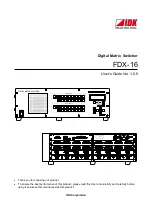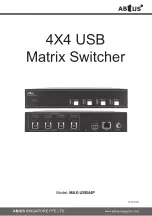
Chapter 4
– Functions
GE Reason Switches
48
REASON SWITCHES-TM-EN-3
2
Ports
The Ethernet ports are the connection between the Physical Layer (copper UTP cable,
with RJ45 connector or fibre optics cable, with LC or ST connector) and the Data Link
Layer. The functions performed by a LAN switch, like Reason Switches, occur mainly
at the Data Link Layer.
Figure 8: Ports at a Transparent Bridge
The ports menu shows the usage possibilities that the equipment is allowed to
perform. As the operation of an Ethernet switch must be as a transparent bridge, it
has to deal with the physical medium where all packet data flows and the end nodes
of an Ethernet network, which are the clients of the transmitting data. Ports
configuration and monitoring allow the user to configure and monitor these issues.
As Ethernet technology has advanced with time, there are several equipment types
that are not able to cope with the newest technology. The evolution from Ethernet to
Fast Ethernet, and then Gigabit Ethernet could be used as example, or from half-
duplex mode (using CSMA/CD protocol to prevent collisions) to full-duplex mode.
Thus, newer technologies are also developed to deal with legacy equipment.
Reason Switches can perform automatic negotiation (auto-negotiation for copper
connections or defined by the optical transceiver) or manual negotiation. When in
manual negotiation, it is possible to define from Ethernet (10 Mbps), Fast Ethernet
(100 Mbps) or Gigabit Ethernet (1 Gbps) in full-duplex or half-duplex mode when using
UTP cables, or to define the operation as full-duplex or half-duplex mode when using
optical fiber cables. This flexibility allows the switches to operate in networks where
equipment which does not support some protocol versions.
Even when using the automatic speed and mode of transmission mode, it is possible
to define which speed and mode will be sent to the connected equipment. By default,
Reason Switches send full capacity (i.e., 1 Gbps for gigabit ports in full-duplex mode
or 100 Mbps for fast Ethernet ports in full-duplex mode), but it is user-configurable.
The Reason Switches are able to switch packets up to 10,056 bytes, and maximum
packet length can be configured. It is possible to define the maximum frame size if
the application requires bigger frames than allowed by the Ethernet (like Jumbo
Summary of Contents for T1000
Page 2: ......
Page 11: ...Figure 97 T1000 dimensions 298 Figure 98 S2020 and S2024G dimensions 299...
Page 12: ......
Page 41: ...Chapter 3 Hardware Design GE Reason Switches REASON SWITCHES TM EN 3 41 Figure 4 S2024G Switch...
Page 256: ......
Page 274: ......
















































